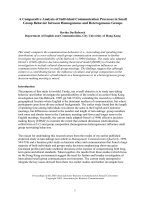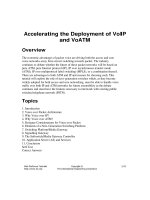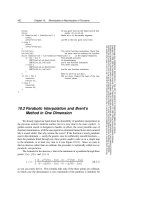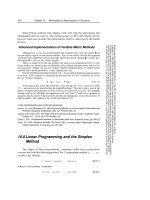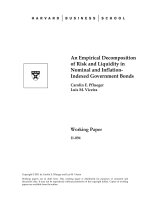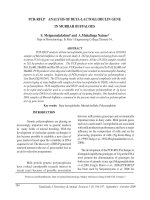Tài liệu An Economic Analysis of Bilateral Investment Treaties pdf
Bạn đang xem bản rút gọn của tài liệu. Xem và tải ngay bản đầy đủ của tài liệu tại đây (1.99 MB, 264 trang )
Jan Peter Sasse
An Economic Analysis of Bilateral Investment Treaties
GABLER RESEARCH
Ökonomische Analyse des Rechts
Herausgegeben von
Professor Dr. Peter Behrens
Professor Dr. Thomas Eger
Professor Dr. Manfred Holler
Professor Dr. Claus Ott
Professor Dr. Hans-Bernd Schäfer
Professor Dr. Stefan Voigt (schriftführend)
Universität Hamburg, Fakultät für Rechtswissenschaft
und Fakultät für Wirtschafts- und Sozialwissenschaft
Die ökonomische Analyse des Rechts untersucht Rechtsnormen auf ihre gesell-
schaftlichen Folgewirkungen und bedient sich dabei des methodischen Instru-
mentariums der Wirtschaftswissenschaften, insbesondere der Mikroökonomie,
der Neuen Institutionen- und Konstitutionenökonomie. Sie ist ein interdisziplinäres
Forschungsgebiet, in dem sowohl Rechtswissenschaftler als auch Wirtschafts-
wissenschaftler tätig sind und das zu wesentlichen neuen Erkenntnissen über
Funktion und Wirkungen von Rechtsnormen geführt hat.
Die Schriftenreihe enthält Monographien zu verschiedenen Rechtsgebieten und
Rechtsentwicklungen. Sie behandelt Fragestellungen aus den Bereichen Wirt-
schaftsrecht, Vertragsrecht, Haftungsrecht, Sachenrecht und verwaltungsrecht-
liche Regulierung.
Jan Peter Sasse
An Economic Analysis
of Bilateral Investment Treaties
With a foreword by Prof. Dr. Thomas Eger
RESEARCH
Bibliographic information published by the Deutsche Nationalbibliothek
The Deutsche Nationalbibliothek lists this publication in the Deutsche Nationalbibliogra e;
detailed bibliographic data are available in the Internet at .
Dissertation Universität Hamburg, 2010
1
st
Edition 2011
All rights reserved
© Gabler Verlag | Springer Fachmedien Wiesbaden GmbH 2011
Editorial Of ce: Stefanie Brich | Sabine Schöller
Gabler Verlag is a brand of Springer Fachmedien.
Springer Fachmedien is part of Springer Science+Business Media.
www.gabler.de
No part of this publication may be reproduced, stored in a retrieval system
or transmitted, in any form or by any means, electronic, mechanical, photo-
copying, recording, or otherwise, without the prior written permission of the
copyright holder.
Registered and/or industrial names, trade names, trade descriptions etc. cited in this publica-
tion are part of the law for trade-mark protection and may not be used free in any form or by
any means even if this is not speci cally marked.
Cover design: KünkelLopka Medienentwicklung, Heidelberg
Printed on acid-free paper
Printed in the Netherlands
ISBN 978-3-8349-2756-9
Foreword
The global economy is characterized not only by a steady increase of international
trade, but also by growing flows and stocks of foreign direct investment (FDI). This
development has manifested itself especially since the mid-1980s. The importance of
FDI in providing foreign markets with goods and services has become comparable to
trade. FDI also constitutes a crucial source of external finance for developing
countries.
An important prerequisite for a high level of FDI is that investors view the political
risk of the host country as manageable. Political risk may, for example, comprise the
danger of expropriation of the investment without adequate compensation, or more
subtle regulatory measures with comparable effects, which are often referred to as
indirect expropriation. The most important legal instruments in international
investment law that may mitigate this kind of risk are bilateral investment treaties
(BITs). Since the first BIT, concluded between Germany and Pakistan in 1959, the
number of such treaties has risen to the impressive number of more than 2700 in 2010.
Despite the undeniable importance of FDI for the global economy and the growing
prominence of BITs, the economic analysis has mainly focussed on international trade
law and has thus far neglected the analysis of international investment law. This
contribution by Jan Peter Sasse seeks, and succeeds, to fill that gap in the existing
literature.
Jan Peter Sasse begins his research by providing a comprehensive analysis of the
economic and legal tools available to international investors who wish to safeguard
their assets abroad. In contrast to the domestic context, international law is generally
characterized by the absence of a supranational authority that may enforce legal
obligations through coercion. Consequently, investors have to rely on economic
devices (the exchange of hostages, for example) or on legal protection through
international law and the possibly unfavourable domestic legislation and judiciary of
host-states. Especially in the light of the lack of a truly multinational treaty on the
protection of FDI, bilateral investment treaties can be considered a cornerstone of
international investment law. Consequently, a number of recent empirical studies find
a positive relationship between the conclusion of BITs and the amount of FDI flows.
The economic analysis of the functioning of BITs must first of all illuminate the
relationship between the investor and the host-state. This relationship may be
characterized by problems of hold-up and asymmetric information. Based on the
rational choice principle as advanced recently by scholars of international law and
economics, Jan Peter Sasse shows to what extent the host-state can overcome the hold-
VI Foreword
up problem through self-commitment. Furthermore, the author convincingly argues
that signaling is only of limited value in counteracting the asymmetry of information
between investors and host-states.
Apart from the relationship between investors and host-states, a thorough analysis of
bilateral investment treaties has to take into account the strategic interaction among
host-states that may consider BITs as an instrument in the competition for FDI. Jan
Peter Sasse analyses this competition in great institutional detail with special attention
devoted to the environmental conflicts that have emerged in the context of
international arbitration. His results show that BITs, if drafted and interpreted with
care, may help capture the beneficial effects of institutional competition and mitigate
the potentially detrimental effects. The author then contributes to two ongoing
discussions in the area of international investment law. Firstly, Jan Peter Sasse
provides an empirical analysis of the impact of BITs on the institutional quality of
developing countries. He finds that external effects of BITs on institutional quality
cannot be verified. The study thus lends empirical support neither to the optimistic
calls for BITs as serving as a positive example for developing countries, nor to the
pessimistic accounts that regard BITs as detrimental to domestic institutional quality.
Secondly, the author provides a systematic analysis of the issue of transparency vs.
confidentiality in international arbitration. Jan Peter Sasse explains why more
transparency may be harmful for the parties involved and that, as a consequence, a
movement towards more transparency in international investment arbitration will be
hard to achieve.
This publication in the field of international law and economics makes a valuable
contribution to our understanding of the functioning of bilateral investment treaties.
Jan Peter Sasse also provides an insightful and well-researched analysis of different
aspects of the protection of FDI through BITs, including institutional competition,
institutional quality, and transparency.
Prof. Dr. Thomas Eger
Acknowledgements
This thesis was written while I was a student at the Doctoral College for Law and
Economics (Graduiertenkolleg für Recht und Ökonomik) and, subsequently, a research
assistant at the Institute of Law and Economics, both at the University of Hamburg. It
would not have been successfully finished without the help and support of a number of
people. I am especially grateful to Thomas Eger, who supervised the thesis and
allowed me to benefit from his helpful comments and advice. Hans-Bernd Schäfer
agreed to act as the second reviewer and was of great support to me (and my fellow
colleagues) as the Speaker of the Graduiertenkolleg. I am grateful to him, other
professors and fellow colleagues, in and around the Graduiertenkolleg, for many
inspiring interactions und discussions during my time in Hamburg. Also, I want to
thank the chairman of the disputation committee, Manfred Holler, who not only
handled the formal dissertation process very efficiently, but also provided helpful
comments during the research process. My thanks go to the editors of the scientific
series “Ökonomische Analyse des Rechts” for giving me the opportunity to publish my
thesis in the series: Peter Behrens, Thomas Eger, Manfred Holler, Claus Ott, Hans-
Bernd Schäfer and Stefan Voigt. I had the pleasure of conducting research as a visiting
scholar at Columbia University (New York) and my gratitude goes to Avery W. Katz
for making this possible. The German Research Foundation (DFG) financially
supported my research both in Germany and the United States with generous research
grants and I am thankful for that.
Additionally, I am indebted to Anne van Aaken, Peter Behrens, Stephania Bonilla,
Eberhard Feess, Henning Fräßdorf, Andrew Guzman, Jonathan Klick, Frank Müller-
Langer, Jan Matauschek, Susan Russell, Stephan Wittig, Katherine Walker and
Tammy de Wright for helpful advice, comments and inspiration during my research
process. Focusing on interdisciplinary research may not be the obvious choice for a
young student of economics. I owe my passion for the economic analysis of law to two
professors who exposed me to this field of research while I was still a graduate student
at the Humboldt University in Berlin: Charles B. Blankart and Christian Kirchner. I
want to thank them for putting me on the right track.
Most importantly, I would like to take this opportunity to thank my father, my sister
and Katrin Stägert for their loving support, kind words, patience and encouragement.
This book is dedicated to the memory of my mother, Hanne Sasse.
Jan Peter Sasse
Summary Contents
FOREWORD V
ACKNOWLEDGEMENTS VII
SUMMARY CONTENTS IX
DETAILED CONTENTS XI
LIST OF FIGURES XIX
LIST OF ABBREVIATIONS XXI
LIST OF VARIABLES 1
1
INTRODUCTION 1
2 FOREIGN DIRECT INVESTMENT 6
3 ECONOMIC AND LEGAL PROTECTION OF FDI 17
4 THE ECONOMICS OF BITS 67
5 BITS AND INSTITUTIONAL COMPETITION 124
6 BITS AND INSTITUTIONAL QUALITY 155
7 BITS AND TRANSPARENCY 177
8 SUMMARY AND OUTLOOK 199
APPENDICES
205
BIBLIOGRAPHY 221
Detailed Contents
FOREWORD V
ACKNOWLEDGEMENTS VII
SUMMARY CONTENTS IX
DETAILED CONTENTS XI
LIST OF FIGURES XIX
LIST OF ABBREVIATIONS XXI
LIST OF VARIABLES 1
1 INTRODUCTION
1
1.1
INTERNATIONAL LAW AND ECONOMICS 2
1.2
STRUCTURE 4
2 FOREIGN DIRECT INVESTMENT
6
2.1
TRENDS AND FIGURES 6
2.2
MULTINATIONAL ENTERPRISES AND FDI 8
2.3
FDI AND DEVELOPMENT 12
3 ECONOMIC AND LEGAL PROTEC
TION OF FDI 17
3.1
TIME INCONSISTENCY AND EXPROPRIATION RISK 17
3.1.1 Time Inconsistency 17
3.1.2 On the Relevance of Expropriation Risk 22
3.2
THE ECONOMICS OF FDI PROTECTION 22
3.2.1 Static Devices 23
3.2.1.1 Hostages 24
3.2.1.2 Collateral 27
3.2.1.3 Hands-Tying 29
3.2.1.4 Union 30
XII Detailed Contents
3.2.1.5 Insurance 31
3.2.1.6 Devaluation of Assets 32
3.2.1.7 Lobbying 32
3.2.2 Dynamic Devices 33
3.2.2.1 Expertise and Time 33
3.2.2.2 Repetition and Reputation 33
3.2.2.2.1 Repetition 33
3.2.2.2.2 Reputation 35
3.2.3 Discussion 40
3.3
LEGAL FDI PROTECTION 40
3.3.1 Domestic Regulation 41
3.3.2 Customary International Law 41
3.3.3 Multilateral Treaties 43
3.3.3.1 WTO 44
3.3.3.2 Energy Charter Treaty 44
3.3.3.3 NAFTA 45
3.3.4 Investor-State Contracts 45
3.3.5 Bilateral Investment Treaties 45
3.3.5.1 Overview and History 46
3.3.5.2 Treaty Practice and Treaty Interpretation 47
3.3.5.3 Preamble and Definitions 48
3.3.5.3.1 Investor 48
3.3.5.3.2 Investment 49
3.3.5.4 Admission 50
3.3.5.5 Standards of Treatment 50
3.3.5.5.1 Fair and Equitable Treatment 50
3.3.5.5.2 Most-Favoured-Nation Treatment 52
3.3.5.5.3 Additional Standards 53
3.3.5.6 Expropriation and Compensation 54
Detailed Contents XIII
3.3.5.6.1 Indirect Expropriation 55
3.3.5.6.2 Compensation 56
3.3.5.7 Public Concerns 57
3.3.5.8 The Settlement of Disputes 58
3.3.5.8.1 ICSID 59
3.3.5.8.2 Remedies 61
3.3.5.8.3 Enforcement and Execution of Arbitral Awards 62
3.3.5.8.4 Costs 63
3.3.5.8.5 Empirical Aspects of Arbitration 63
3.3.5.9 BITs and Customary International Law 64
3.3.5.10 Summary 65
4 THE ECONOMICS OF BITS
67
4.1
THE (PERCEIVED) WEAKNESS OF INTERNATIONAL LAW 67
4.2
THE EFFECT OF BITS ON FDI 69
4.2.1 Empirical Studies on the Effect of BITs on FDI 69
4.2.2 Discussion 72
4.3
LAW AND ECONOMICS OF INTERNATIONAL LAW 73
4.3.1 Theories of International Law 74
4.3.2 Rational Choice Approach 74
4.3.3 Methodological Individualism 75
4.3.4 The Three R's: Reputation, Reciprocity and Retaliation 76
4.4
THE FUNCTIONING OF BITS 78
4.4.1 The Costs of BITs 78
4.4.1.1 Concluding BITs 79
4.4.1.2 Breaching BITs: The Three R's Revisited 79
4.4.1.2.1 Reciprocity and Retaliation 79
4.4.1.2.2 Reputation vis-à-vis Other States 80
4.1.1.2.3 Reputation vis-à-vis Investors 81
XIV Detailed Contents
4.4.1.3 Breaching BITs: Non-Reputational Costs 83
4.4.1.4 Summary 84
4.4.2 Commitment and Signalling 84
4.4.3 Commitment 85
4.4.3.1 Repetition Revisited 86
4.4.3.2 The Commitment Game 86
4.4.3.2.1 The Tribunal's Decision 89
4.4.3.2.2 The Arbitration Decision 89
4.4.3.2.3 The Expropriation Decision 90
4.4.3.2.4 The Investment Decision 91
4.4.3.3 Equilibria 92
4.4.3.4 Hostages and Collateral 93
4.4.3.5 Extensions 94
4.4.3.5.1 Compliance and Enforcement in Third Countries 94
4.4.3.5.2 Settlement vs. Trial 95
4.4.3.5.3 The Perils of Success 100
4.4.3.6 Summary 101
4.4.4 Signalling 102
4.4.4.1 Reputation Revisited 102
4.4.4.2 Signalling Theory 104
4.4.4.3 Rights and Treaties as Signals 105
4.4.4.4 The Signalling Game 107
4.4.4.5 Equilibria 110
4.4.4.6 Hidden Characteristics and Hidden Intentions 114
4.4.4.7 Summary 116
4.4.5 Beyond Commitment and Signalling 117
4.4.5.1 Flexibility vs. Commitment 117
4.4.5.2 BITs as Development Aid 118
4.4.5.3 Risk Aversion 119
Detailed Contents XV
4.5 EMPIRICAL STUDIES AND THE FUNCTIONING OF BITS 120
4.6
DISCUSSION AND CONCLUSIONS 121
5 BITS AND INSTITUTIONAL COMPETITION
124
5.1
EFFICIENCY AND BITS 124
5.2
INSTITUTIONAL COMPETITION 127
5.2.1 BITs and the Prisoner’s Dilemma 127
5.2.2 The Economics of Institutional Competition 129
5.2.2.1 Tax Competition 131
5.2.2.2 Environmental Competition 133
5.2.3 Discussion 135
5.3
BITS IN THE CONTEXT OF INSTITUTIONAL COMPETITION 136
5.3.1 BITs and Self-Interested Governments 137
5.3.1.1 Political Economy and International (Trade) Law 137
5.3.1.2 Political Economy and International Investment Law 139
5.3.2 BITs and the Prisoner's Dilemma Revisited 142
5.3.2.1 BITs and the Underprovision Hypothesis 142
5.3.2.2 Distribution of the Benefits of FDI 144
5.4
PROVISIONS AND EVIDENCE 145
5.4.1 Non-Discrimination 145
5.4.2 Fair and Equitable Treatment (FET) 146
5.4.3 Indirect Expropriation 147
5.4.4 Evidence 148
5.4.4.1 Case Law 148
5.4.4.2 Analysis 151
5.5
DISCUSSION AND CONCLUSIONS 152
6 BITS AND INSTITUTIONAL QUALITY
155
6.1
THE EFFECT OF BITS ON INSTITUTIONAL QUALITY 155
XVI Detailed Contents
6.1.1 Some Theory 155
6.1.2 Empirical Literature 158
6.2
MODEL AND DATA 160
6.2.1 Fixed-Effects Model 160
6.2.2 Variables 162
6.2.2.1 Dependent Variables 162
6.2.2.2 Independent Variables 163
6.2.2.3 Overview 165
6.2.3 Summary Statistics 166
6.2.4 Regulatory Quality and the Rule of Law 166
6.2.5 Corruption 172
6.2.6 Outliers, Economic Freedom and OECD BITs 173
6.3
CAVEATS 173
6.3.1 Selection and Composition of Variables 174
6.3.2 Perception Based Indicators 174
6.4
DISCUSSION AND CONCLUSIONS 175
7 BITS AND TRANSPARENCY
177
7.1
LEGAL BACKGROUND 177
7.2
THE CASE FOR TRANSPARENCY 181
7.2.1 International Law 181
7.2.2 International Investment Law 183
7.3
THE CASE FOR CONFIDENTIALITY 184
7.3.1 Conventional Arguments for Confidentiality 185
7.3.2 Structural Arguments for Confidentiality 186
7.3.2.1 Informational Ambiguities and the Incentive to Comply 186
7.3.2.2 Efficient Breach and Settlement Problems 190
7.3.2.3 The Incentive to Conclude an Agreement 194
7.3.3 More Transparency? 196
Detailed Contents XVII
7.4 DISCUSSION AND CONCLUSIONS 196
8 SUMMARY AND OUTLOOK
199
8.1
SUMMARY 199
8.2
OUTLOOK 203
APPENDICES
205
A
PPENDIX A 205
A
PPENDIX B 207
A
PPENDIX C 211
A
PPENDIX D 216
BIBLIOGRAPHY 221
List of Figures
Figure 2.1: FDI Flows (Inward) 1970-2009 7
Figure 2.2: FDI Flows (Inward) – Selected Countries and Regions 8
Figure 3.1: Time Inconsistency 19
Figure 3.2: Hostage-Mechanism 26
Figure 3.3: Collateral 28
Figure 3.4: Hands-Tying 29
Figure 3.5: Time Inconsistency and the Good Host Country (HC
good
) 37
Figure 4.1: The Commitment Game 88
Figure 4.2: The Signalling Game 109
List of Abbreviations
BIT Bilateral Investment Treaty
CIEL The Center for International Environmental Law
CIL Customary International Law
DCF Discounted Cash Flows
DSB Dispute Settlement Body (World Trade Organization)
EBIT Earnings Before Interest and Taxes
ECT Energy Charter Treaty
EU European Union
FCN Treaty of Friendship, Commerce and Navigation
FDI Foreign Direct Investment
FET Fair and Equitable Treatment
FMV Fair Market Value
FPI Foreign Portfolio Investment
FTC Free Trade Commission
GATS General Agreement on Trade in Services
GATT General Agreement on Tariffs and Trade
GDP Gross Domestic Product
GNI Gross National Income
HC Host Country
ICC International Chamber of Commerce
ICJ International Court of Justice
ICSID International Centre for the Settlement of Investment Disputes
IISD International Institute for Sustainable Development
IMF International Monetary Fund
LDC Least Developed Countries
M&A Mergers and Acquisitions
MAI Multilateral Agreement on Investment
XXII List of Abbrevations
MIGA Multilateral Investment Guarantee Agency
MFN Most Favoured Nation
MNE Multinational Enterprise
NAFTA North American Free Trade Agreement
NE Nash Equilibrium
NGO Non-Governmental Organisation
OAS Organization of American States
OECD Organisation for Economic Cooperation and Development
OPIC Overseas Private Investment Corporation
PBE Perfect Bayesian Equilibrium
PCA Permanent Court of Arbitration
PD Prisoner's Dilemma
SCC Stockholm Chamber of Commerce
TRIMS Trade-Related Investment Measures
TRIPS Agreement on Trade-Related Aspects of Intellectual Property
Rights
UN United Nations
UNCITRAL United Nations Commission on International Trade Law
UNCTAD United Nations Conference on Trade and Development
USD US-Dollar
VCLT Vienna Convention on the Law of Treaties
WGI World Governance Indicators
WTO World Trade Organization
List of Variables
C
M
= Cooperation gain for the MNE (profit)
C
H
= Cooperation gain for the host country (taxes, spillover etc.)
L
M
= Loss for the MNE in case of expropriation (Loser's payoff)
W
H
= Value of the assets to the host country if expropriated (Winner's payoff)
į = Discount rate of the host country
X = Collateral/Hostage
D = Damages/Compensation
ș = Probability that the host country is reliable
q
2
= Probability that the host country is reliable as assessed by the MNE in
period two
z = Probability that the bad type will play accommodation in the first period
v = Probability that MNE plays invest
y = Probability of error
T = Litigation costs
R = Reputational loss
S = Settlement costs
A
= Costs of concluding the BIT
B
R
= Compliance costs of the BIT for the reliable type (arbitration risk)
B
U
= Compliance costs of the BIT for the unreliable type (arbitration risk)
